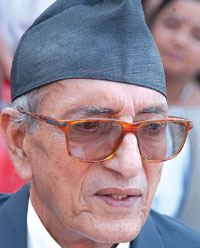|
|
There are so many reasons why the parties and people feel skeptical about the Maoists: Prachanda's often insulting remarks against other political leaders, his utter arrogance unsuitable for a senior leader like him, his clever attempts to opt out seven parties from decision making process, and the continued violence, abduction and extortions at the hands of his cadres, abductions and lack of guilt about the past mistakes.
Many questions are being raised about the intentions of the Maoists: are they really serious about giving up their one-party stance and joining the multiparty system or is it just their political diplomacy to win the hearts of the mass? Is their alliance with the seven parties genuine or merely a way to use them? The Maoists had not organised any political struggle during the Panchayat regime. They took up arms only when the communist party formed a government following general elections and had started to undertake new progressive activities. There would have been a lot of progress if all the leftist parties had formed a majority in the government. But it seems very clear now that there were very close relations between the Maoist leadership and King Birendra. During that time, efforts were being made through Gyanendra and Dhirendra to unite with the Maoists and destroy the leading parties like Nepali Congress and UML. Soon after the royal massacre, Prachanda and Baburam had praised kings from Prithbi Narayan Shah to Birendra. They started the extortions and killings of hundreds of leaders, workers, teachers, journalists and many police and army personnel while during off duty and visiting their families. After this, the Maoists took refuge in India and mobilised their militia and then came to the country to start destruction of public and private properties.
The whole country and the people had been suffering at the hands of the palace in the cities and Maoists in the jungle. Thousands were killed for extortion and not supporting the rebels. The properties of tens and thousands of families were looted and over 100,000 displaced. The Maoists believed that the whole country was under their control. But it was only after their alliance with the parties especially NC and UML that led to huge assemblies of the mass. But Baburam now says this was possible due to the Maoists. He added that only few supported the parties.
How many Maoists really got martyred during Janandolan II? How many of their cadres really got injured? When Gyanendra assumed direct rule, the Maoists said that he betrayed them. Until then, the Maoists had still not had any serious talks or reached an understanding. On the other hand, the parties were criticised for not showing courage to organise mass protest against the king.
By the time, the Maoists had been attacking many districts, brutally destroying the infrastructure and buildings in the cities and towns. But when they realised that it was not possible to capture Kathmandu and win a decisive war in the capital, the Maoist leaders eventually thought of the proposal for talks by the parties. It was only after the janandolan got stronger that they started the drama of trying to have talks. Now Prachanda is saying that the parties did not have much to do with the 12-point understanding.
It's good that he has started to talk a lot about the Buddha. But it's time that he started sounding like a responsible leader, wholeheartedly accepting multiparty system, publicly admitting the past mistakes and liberating from old stereotyped thinking.





